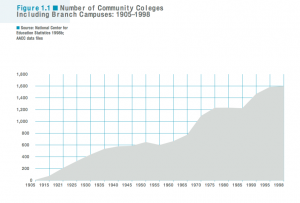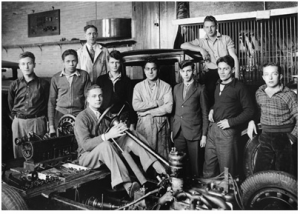Why were community colleges founded in the United States and have they maintained their original goals?
Community colleges, formally called junior colleges, provide the populations of their surrounding communities with higher education opportunity. These colleges provide associate degrees, certificate programs, developmental courses, vocational programs, distance learning opportunities, flexible scheduling, childcare, veteran resources, counseling, and employment for the communities they reside in. They provide these resources at a fraction of the cost of the traditional four- year colleges and universities. Community colleges are currently reporting record high enrollment rates; seven million students were attending community college in 2009. 1 High enrollment has lead to closer examination of their results. These institutions are under tremendous scrutiny for low retention and graduation rates. Perhaps, a look at history can uncover what has resulted in the under performance of our countries community colleges. Why were community colleges founded in the United States and have they maintained their original goals?

In the early twentieth century community colleges were founded on the belief that a more skilled workforce would result in a stronger economy. Enrollment in high schools had increased, and additional higher education prospects were necessary 2 The history of community college creation is what I hope to examine. What were the original goals, and intentions for these institutions? Who were the original supporters of community colleges? Where were these colleges founded? Who were the first students to attended community colleges and what were their prospects upon completion? Finally, how were community colleges funded? To assist in answering some of these questions, primary source data is available at the American Association of Colleges, which houses a historical photo gallery and timeline of community college development.

I hope to continue this research by examining the success of the early community colleges and compare that success to the community colleges of today. How did community colleges of the past contribute to the socio-economic mobility of their students? How did they respond to economic trends of the United States, and were they as scrutinized as community colleges are today? Secondary source information in “Diverted Dream” by Steven Brint and Jerome Karabel, a book about “community colleges and the promise of educational opportunity in America 1900-1985” and in “Gateway to Opportunity” by J. M. Beach will assist in answering the historical questions and provide further sources for primary data. Furthermore, I will obtain the data available through the National Center for Educational Statistics on the enrollment and retention rates of community college, which dates back to 1963 3 Additionally, I will utilize the data provided by The National Educational Longitudinal Study to help facilitate understanding of population demographics of students who have attended community college at different times throughout the past century.
While maintaining the underlying goal of the research, I am hoping that by learning who community college students were at various points in history, will provide a better analysis of the intended goals of community colleges. Have the student populations of community colleges changed over time and have they shifted the goals or purpose of community college education? As goals and directions may have shifted how were they influenced by political pressure. In 2012 President Obama commissioned eight million dollars to go towards developing a career path for community college students 4 Were community colleges always a part of political education policy? How has politics and policy affected their goals, and rates of success?
A journal article published by Teachers College at Columbia University in 2011 “The Growth of Community Colleges in the American States: An Application of Count Models to Institutional Growth” utilizes statistical regression and data on all fifty states to suggest that political force has only small affect on the role of community colleges. It states, “This study provides support for the idea that the supply of higher education institutions is responsive to demand. Little support is found for the role of social stratification in the development of new institutions. Political forces do appear to play at least a small role in the expansion of institutions. Existing institutions may slow the growth of newer forms of post secondary education” 5 Yet, presidents as far back as Harry Truman and as recent as Obama have provided funding and addressed the state and success of community colleges 6
Today community colleges are frequently in the media. They are examined for their cost, their enrollment, their retention, their graduation rates, their curriculum and their transfer rates. The Chronicle, a publication dedicated to the news of higher education has an entire weekly newsletter responsible for reporting the news of community colleges. Some of their articles include “Community-College Dropouts Cost Taxpayers Nearly $1-Billion a Year” and “Success Programs at Community Colleges -Often Offered, Rarely Required-Miss Many Students” are at the heart of some of the newest criticism on community colleges. The New York Times has featured pieces titled “Two-Year Colleges, Swamped, No Longer Welcome All” and “Community Colleges Need to Improve Graduation Rate” these provide proof of the current pressure that community colleges are faced with. I hope this recent media attention will help analysis when answering how community colleges are counseling, providing, and educating their seven million students? Have their goals remained the same or have they changed?
I am a graduate of community college. At community college I was provided a space to develop skills in writing, reading, and math that were never before taught to me. I was provided a community, a group of supporters who understood the precarious nature of the adult student. I was provided guidance on how to achieve and advance in my educational pursuits. I would not be at Trinity College, without community college. The topic is not only relevant because of increasing enrollment rates or media attention – it is relevant to me, and my own aspirations for educational success and completion.
Additional Works Consulted
Anon. 2012. “Community Colleges Past to Present.” American Association of Community Colleges. http://www.aacc.nche.edu/AboutCC/history/Pages/pasttopresent.aspx.
Anon. “Digest of Education Statistics, 2010.” http://nces.ed.gov/programs/digest/d10/tables/dt10_201.asp.
Anon. 2012. “Low Graduation Rates at 2-Year Colleges Affect Students and State Governments, Report Says”. The Chronicle of Higher Education. The Ticker. http://chronicle.com/blogs/ticker/low-graduation-rates-at-2-year-colleges-affect-students-and-state-governments-report-says/41961.
Anon. “Badillo Says Community Colleges Need to Improve Graduation Rate – New York Times.” http://www.nytimes.com/1999/12/01/nyregion/badillo-says-community-colleges-need-to-improve-graduation-rate.html?ref=communitycolleges.
Brint, Steven, and Jerome Karabel. 1991. The Diverted Dream: Community Colleges and the Promise of Educational Opportunity in America, 1900-1985. Oxford University Press, USA.
Beach, J. M. 2011. Gateway to Opportunity: A History of the Community College in the United States. Stylus Publishing.
Doyle, William, and Alexander Gorbunov. 2011. “EBSCOhost: The Growth of Community Colleges in the American States: An Application of …” Teachers College Record 113 (8) (August): p1794–1826.
Foderaro, Lisa W. 2009. “Two-Year Colleges, Swamped, No Longer Welcome All.” The New York Times, November 12, sec. Education. http://www.nytimes.com/2009/11/12/education/12community.html.
Lewin, Tamar. 2012. “Obama Budget Seeks Job Training at Community Colleges.” The New York Times, February 13, sec. Education. http://www.nytimes.com/2012/02/14/education/obama-to-propose-community-college-aid.html.
Supiano, Beckie. “In California, Private Colleges Benefit From Public System’s Shrinking Capacity – Students – The Chronicle of Higher Education.” http://chronicle.com/article/In-California-Private/131331/.
Thomas, Jacqueline Rabe. “Report: Community College Graduation Rate Lags | The Connecticut Mirror.” http://ctmirror.org/story/11893/grad-rates.
Weisberger, Ronald. 2005. “EBSCOhost: Community Colleges and Class: A Short History.” Teaching English in the Two Year College 33 (2) (December): 127–142. ERIC.
- Anon. “Digest of Education Statistics, 2010.” http://nces.ed.gov/programs/digest/d10/tables/dt10_201.asp. ↩
- Anon. 2012. “Community Colleges Past to Present.” American Association of Community Colleges. http://www.aacc.nche.edu/AboutCC/history/Pages/pasttopresent.aspx. ↩
- Anon. “Digest of Education Statistics, 2010.” http://nces.ed.gov/programs/digest/d10/tables/dt10_201.asp. ↩
- Lewin, Tamar. 2012. “Obama Budget Seeks Job Training at Community Colleges.” The New York Times, February 13, sec. Education. http://www.nytimes.com/2012/02/14/education/obama-to-propose-community-college-aid.html. ↩
- Doyle, William, and Alexander Gorbunov. 2011. “EBSCOhost: The Growth of Community Colleges in the American States: An Application of …” Teachers College Record 113 (8) (August): p1794–1826. ↩
- Anon. “Community Colleges Past to Present.” American Association of Community Colleges. http://www.aacc.nche.edu/AboutCC/history/Pages/pasttopresent.aspx. ↩
At the time of posting the foot note formatting on wordpress was not functioning correctly. I was utilizing the standard [1. Insert Citation. ] yet, it was still producing very funky formatting and affecting text of piece.
Fionnuala, I inserted a sample footnote and it’s working fine for me. See above and update your post if you wish, or if problems continue, let me know.
As you can see I was able to insert foot notes. (4.6.12 4:48p)
Fionnuala, as we discussed, the evolution of community colleges is an interesting topic, and you’ve done relevant background reading, but your research question needs more focus to succeed in this writing assignment. Here is the revised RQ that you drafted during our conversation: “How did community colleges contribute to the socio-economic mobility of their students from the 1960s to the present?” If that becomes too large for the scope of this assignment, you can always modify again into something like: “How did community colleges contribute to the SE mobility of their students in the 1960/70s, and is it different or similar today?” The latter version would allow you to compare two periods, rather than describing everything that happens in between. Once again, this revised question format focuses more on actual outcomes rather than simply policy goals.
Another optional ending for your revised RQ could be: “. . .different or similar today, in the US in general and Connecticut in particular?” Doing this would allow you to focus on national trends (see Brint & Karabel, et al.), but inserting as much of the CT story as you find available in relevant sources (such as Hartford Courant Historical or specific CT community college reports at Trinity Library or elsewhere in CT library system.) In other words, if sources permitted, you could write about whether Brint & Karabel’s framework fits the CT story — or not.
Regarding sources about socio-economic mobility and higher education, I suspect that historically-minded sociologists Brint and Karabel are your best starting point, and maybe Beach is worth reading.
You may also find value in a sociologically-mind historian such as historical commentary by John L. Rury, Education and Social Change: Contours in the History of American Schooling, Third Edition (New York: Routledge, 2009). If you can’t find it at the library, I have a copy somewhere.
I’ll also email you a sample chart I constructed with US census data on income levels for college degrees changing since 1967, in case you wish to dig into similar material with a CC focus.